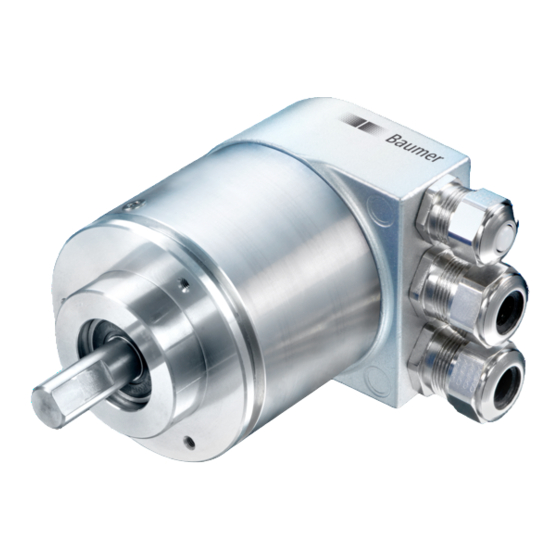Baumer X 700 Manual - Página 5
Procurar online ou descarregar pdf Manual para Conversor de multimédia Baumer X 700. Baumer X 700 41 páginas. Absolute encoder profibus-dpv0 (with bus cover and ssi coupler)
Também para Baumer X 700: Manual (26 páginas)

3. CAN Bus and CANopen Communication
3.1. CAN bus
The CAN bus (CAN: Controller Area Network) was originally developed by Bosch and Intel for fast,
inexpensive data transmission in motor vehicle technology. Today the CAN bus is also used in industrial
automation.
The CAN bus is a field bus (the standards are defined by the association CAN in Automation (CiA)) via which
devices, actuators and sensors of different manufacturers can communicate with each other.
3.1.1. CAN bus properties
• Data rate of 1 Mbaud with a network range of up to 40 m (130 ft)
• Network connected at both ends
• Bus medium twisted-pair cables
• Real-time capability: defined maximum wait time for high-priority messages.
• Theoretically 127 nodes to a bus, however physically only 32 (due to the driver used).
• Securing of network-wide data consistency. Faulty messages are made known to all network nodes as
faulty.
• Message-oriented communication
The message is marked with an identifier. All network nodes check whether the message is relevant for
them using the identifier.
• Broadcasting, multicasting
All network nodes receive every message simultaneously, enabling synchronization.
• Multi-master capability
Every node in the field bus can send and receive data independently without being dependent on a priority
of the master. Each can begin its message if the bus is not busy. In the case of simultaneous transmission
of messages, the node with the highest priority prevails.
• Assignment of priorities to messages
The identifier specifies the priority of the message. As a result, important messages can be transmitted
quickly via the bus.
• Residual error probability
Safe-guarding methods in the network reduce the probability of an undetected, faulty data transmission to
-11
below 10
. A virtually 100 % reliable transmission can be assumed.
• Operation monitoring
Localization of defective or failed stations. The CAN protocol contains an operation monitoring function of
network nodes. The operation of defective network nodes is restricted, or they are completely decoupled
from the network.
• Data transmission with a short error recovery time
Due to several error detection mechanisms, falsified messages are recognized with a high probability. If an
error is detected, then the message is automatically retransmitted.
Several network nodes are interconnected via a bus cable. Each network node can send and receive
messages. The data are transmitted serially between the network nodes.
Examples of network nodes for CAN bus devices are:
• Automation devices, e.g. PLC
• PCs
• Input/output modules
• Drive controllers
• Analysis devices, e.g. a CAN monitor
• Operating and input devices as human-machine interface (HMI)
• Sensors and actuators
Manual_GXP5_417_Lift_EN.doc
04.05.11
5/41
Baumer IVO GmbH & Co. KG
Villingen-Schwenningen, Germany
